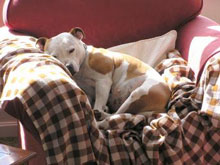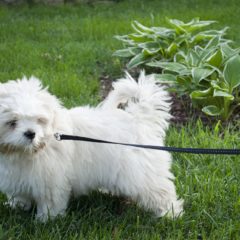 Chances are, you wouldn’t consider bringing a wild animal into your home. After all, if you caught a squirrel and brought it into your house to live, you probably wouldn’t be surprised if it chewed your couch, ate your plants or pooped on your rug. As a wild animal who normally lives outside, a squirrel simply wouldn’t know any better and would do whatever instinctively comes to it.
Chances are, you wouldn’t consider bringing a wild animal into your home. After all, if you caught a squirrel and brought it into your house to live, you probably wouldn’t be surprised if it chewed your couch, ate your plants or pooped on your rug. As a wild animal who normally lives outside, a squirrel simply wouldn’t know any better and would do whatever instinctively comes to it.
So how does this relate to dog training? After all, this is a dog behavior web site! The thing is, the same is true for any animal that normally lives outdoors and you then bring inside, including dogs.
Some pet owners choose to have their dog live outside the majority of the time for any number of reasons. Perhaps this is the way dogs have always been cared for in their family, or maybe they feel it’s nicer for the dog to enjoy the outdoors as much as possible. As long as food, water, shelter, veterinary care and attention are given to the dog on a regular basis, this may not seem like a problem at all.
However for most people, there will be times when they do want to bring their dog indoors. Many families leave their dog out while they’re at work, but want to bring him in at night. Others bring their dog in only when weather becomes extreme.
The problem is, unless you’ve brought your dog inside and taught him the rules of the house on a regular basis, he will not know how he’s expected to behave indoors. He may do the same things as any untrained animal, including chewing the couch, eating the plants and pooping on the rug.
Unsupervised behavior outdoors often leads to dogs who chew bushes, dig holes and don’t have the muscle control to “hold in” their business. Not surprisingly, this can lead to a dog who does the same things indoors… he simply may not know any differently.
Often, this leads to a cycle where the dog doesn’t behave when inside, so he’s left outside. The more he’s outside, the less he behaves inside. If this is the case, the cycle can be broken by working with your dog on some obedience commands and manners.
In the beginning, you may need to use your dog’s leash when he’s inside to help control him and teach what’s appropriate. For example, if he tries to leap up onto the sofa, you can tell him “no,” prevent him from getting on, and have him “sit” next to it instead. Be sure to follow with lavish praise when he’s doing the right thing.
The examples could go on and on, with the basic principle being to prevent/correct inappropriate behaviors and redirect/teach the ones that you want. Remember, if your dog doesn’t spend enough supervised time inside, he simply will not know how to behave!
Working with a professional trainer in your home can be very helpful as well. By putting in a little work now, your “wild animal” can soon be the gentle, domesticated pet you originally envisioned!
Lori Verni-Fogarsi has been an author, speaker, small business consultant, and Certified Master Trainer for 18+ years. Her novel, “Momnesia,” (contemporary women’s fiction) has been designated a National Indie Excellence Book Awards Finalist, and her nonfiction book, “Everything You Need to Know About House Training Puppies and Adult Dogs,” has been widely acclaimed in its genre. To learn more, please visit www.LoriTheAuthor.com and join Lori on Facebook at www.facebook.com/LoriTheAuthor.








